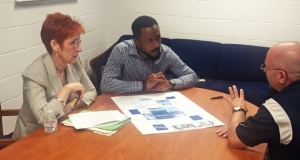Dillard Middle to offer new programs, change schedule
By Phyllis Moore
Published in News on June 16, 2016 1:46 PM

News-Argus/PHYLLIS MOORE
Dillard Middle School Principal Sonja Emerson, left, and assistant principal Jamel Jones talk with Andy Forsleff, lead science teacher for Wayne County Public Schools, about efforts to incorporate more project-based learning opportunities for students in the fall.
Since becoming principal at Dillard Middle School in 2012, veteran educator Sonja Emerson admits it has been tough.
"We had a lot of teacher turnover, some that just left and some that needed to leave. Some that we needed to help them find another place to either teach or another career," she said. "When you build a staff and you have a new staff, it's a lot of work. You have lots of observations.
"We have lots of things. We have a lot of tears we dry, but (it's important to) build that staff and have them return and not leave and be committed to the school and want to be there."
The hard work has been compounded by the school's being on the low-performing list. More than once.
The state does not take that lightly, which Mrs. Emerson knew.
"We knew what that turnaround principle, that option, was going to look like and what it meant," she said. "I went home and digested that because you know, that No. 1 says, 'Replace the principal.'
"That scared me, OK? Because I don't want to be replaced, because I love the school. I want to be there."
Mrs. Emerson recently met with the school board's curriculum and instruction committee, recounting the struggle -- the sleepless nights -- in the aftermath of the latest test scores released in the fall.
To clarify, though, Tamara Berman-Ishee, assistant superintendent for curriculum with the district, had to interrupt.
"Option 1, 'Replace the principal' goes on to say 'or,'" she began.
"You don't see that, do you?" Mrs. Emerson said with a laugh. "I stopped right there."
"'Or prove that the leadership of the school is the correct person to lead the turnaround,'" Ms. Ishee explained.
Mrs. Emerson said she and her assistant principal, Jamel Jones, began to do the research and craft a plan they say will "create a new Dillard" into an enviable and successful environment.
Efforts had already begun earlier in the school year, with Dillard forging a partnership with Wayne School of Engineering and its principal, Gary Hales. Daily "professional learning community meetings" kicked off each school day for teachers, with the student schedule restructured to start and end later.
That will continue, the educators said.
They are proposing an 8 a.m. until 4 p.m. staff workday, starting with the morning professional development from 8-8:45. Students will start classes at 9 a.m. and be dismissed for the day at 3:45 p.m.
"Middle school students need to come later, 8:30 versus 7 o'clock in the morning -- kids are not asleep, kids are on time. Our tardies have decreased dramatically," Mrs. Emerson said of the past year.
Project-based learning will also become foundational, the administrators said.
"When we saw the movie, 'High Tech High' (sponsored by the district at Paramount Theatre last month), it was difficult for us to sit in there and watch that because we have been talking about this since January. It was like, oh, my gosh, we are on the right track," the principal said. "We know that we can't make Dillard High Tech High, but two or three years down the road, that's our vision."
What will essentially drive the school moving forward, Jones said, is the last hour of the school day -- an hour-long block where students choose their areas of interest and develop their individual strengths.
Students will be able to pick from a wider range of electives, such as cooking and entrepreneurship, while teachers will be given the chance to apply their own unique talents and abilities to work in those directions as well.
"It's project-based learning, that elective block. It empowers students, it empowers the staff, administration, everybody in the building," he said.
"We want to teach our students how to be leaders. We want to teach them how to give back and we want to teach them how to work together."
The impetus behind the effort is to take away the "why factor," as in, "Why do I have to learn this?" Jones said.
But perhaps the best part, the administrators said, is the proposed Tiger Academy, a "school within a school" and a way to meet the needs of students who might otherwise fall through the cracks.
"It dawned on me, it's not about behavior, it's about lack of academic success," Mrs. Emerson said. "So we turned our whole mindset around and are focusing on an academic success model."
Tiger Academy will be housed in a wing of the school, feature project-based learning, and smaller classrooms -- 12 students per homeroom or approximately 72 students in the program -- all done through an application process.
"We're looking at students who learn differently. It's a true alternative option," Jones said, for those students challenged by sitting still and learning by the conventional way.
With an eye on launching in the fall, the plan is quickly taking shape.
Students accepted into the Tiger Academy program will be able to attend a two-day orientation later this summer, while educators will participate in a week-long teacher academy and a leadership academy will indoctrinate them into the project-based learning concepts.
School board members on the curriculum and instruction committee were responsive to the approach.
Pat Burden said she liked the concept, suggesting students also be given exposure to public speaking, to ultimately speak more confidently.
